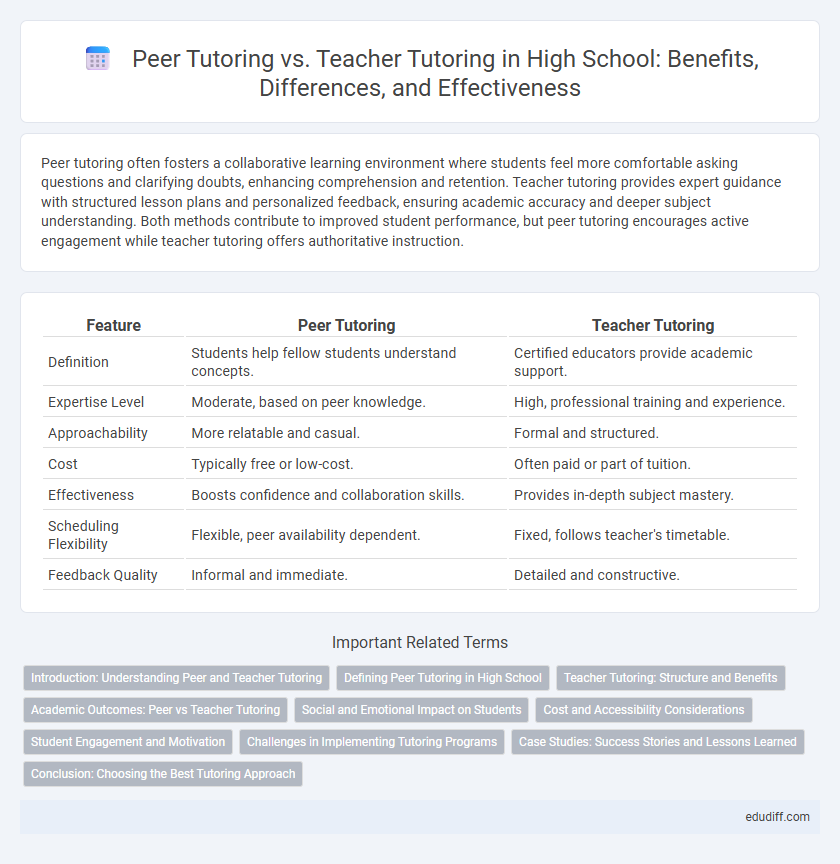Peer tutoring often fosters a collaborative learning environment where students feel more comfortable asking questions and clarifying doubts, enhancing comprehension and retention. Teacher tutoring provides expert guidance with structured lesson plans and personalized feedback, ensuring academic accuracy and deeper subject understanding. Both methods contribute to improved student performance, but peer tutoring encourages active engagement while teacher tutoring offers authoritative instruction.
Table of Comparison
| Feature | Peer Tutoring | Teacher Tutoring |
|---|---|---|
| Definition | Students help fellow students understand concepts. | Certified educators provide academic support. |
| Expertise Level | Moderate, based on peer knowledge. | High, professional training and experience. |
| Approachability | More relatable and casual. | Formal and structured. |
| Cost | Typically free or low-cost. | Often paid or part of tuition. |
| Effectiveness | Boosts confidence and collaboration skills. | Provides in-depth subject mastery. |
| Scheduling Flexibility | Flexible, peer availability dependent. | Fixed, follows teacher's timetable. |
| Feedback Quality | Informal and immediate. | Detailed and constructive. |
Introduction: Understanding Peer and Teacher Tutoring
Peer tutoring in high schools fosters collaborative learning by enabling students to explain concepts in relatable language, enhancing comprehension and retention. Teacher tutoring offers expert guidance and structured instruction, leveraging professional training to address individual academic needs effectively. Both methods contribute uniquely to student success, with peer tutoring promoting engagement and teacher tutoring ensuring accuracy and depth of knowledge.
Defining Peer Tutoring in High School
Peer tutoring in high school involves students helping classmates understand course material, enhancing learning through relatable explanations and collaborative engagement. This method promotes active participation, builds communication skills, and fosters a supportive academic environment. Research indicates that peer tutoring improves comprehension, motivation, and retention, complementing traditional teacher-led instruction.
Teacher Tutoring: Structure and Benefits
Teacher tutoring in high schools provides a structured learning environment guided by experienced educators who can tailor instruction to individual student needs and curriculum standards. This method ensures consistent feedback, accurate assessment of student progress, and the use of professional teaching strategies to address learning gaps effectively. Research shows that teacher tutoring often leads to higher academic achievement and deeper understanding compared to peer tutoring due to expert knowledge and pedagogical skills.
Academic Outcomes: Peer vs Teacher Tutoring
Peer tutoring in high schools often enhances academic outcomes by promoting active engagement and personalized support among students. Teacher tutoring provides expert knowledge and structured guidance that can address complex learning challenges effectively. Studies show a combination of peer and teacher tutoring maximizes comprehension, retention, and overall academic success in high school environments.
Social and Emotional Impact on Students
Peer tutoring in high schools fosters a collaborative learning environment that boosts students' social skills and emotional confidence through relatable interaction and mutual support. Teacher tutoring provides structured guidance and expert feedback, enhancing students' academic self-efficacy and reducing anxiety. Both approaches contribute distinctly to students' emotional well-being, with peer tutoring promoting empathy and social bonding, while teacher tutoring offers reassurance and authoritative mentorship.
Cost and Accessibility Considerations
Peer tutoring in high schools often reduces costs significantly by utilizing trained students, making it an accessible option for schools with limited budgets. Teacher tutoring, while potentially more costly due to staff salaries, provides expert guidance and personalized instruction that may not be replicable through peer support. Accessibility in peer tutoring programs is enhanced by flexible scheduling and relatability among students, whereas teacher tutoring may face constraints related to availability and class size limits.
Student Engagement and Motivation
Peer tutoring in high schools often boosts student engagement by fostering collaborative learning environments where students feel more comfortable asking questions and taking academic risks. Teacher tutoring provides structured guidance and expert feedback, which can enhance motivation through personalized instruction and goal-setting. Research indicates that combining peer and teacher tutoring strategies maximizes student motivation and sustained engagement in learning activities.
Challenges in Implementing Tutoring Programs
Peer tutoring programs in high schools often face challenges such as lack of standardized training and inconsistent student commitment, which can hinder the effectiveness of academic support. Teacher tutoring encounters obstacles like limited availability due to heavy workloads and scheduling conflicts with regular classes. Both models struggle with maintaining consistent student motivation and ensuring alignment with curriculum standards for optimal learning outcomes.
Case Studies: Success Stories and Lessons Learned
Case studies reveal that peer tutoring in high schools boosts student engagement and fosters collaborative learning, often leading to improved academic achievement and confidence. Teacher tutoring provides structured guidance and expert feedback, critical for addressing complex subjects and personalized learning needs. Success stories highlight the complementary benefits of combining peer and teacher tutoring, emphasizing lessons on balancing student autonomy with professional support for optimal outcomes.
Conclusion: Choosing the Best Tutoring Approach
Peer tutoring fosters collaborative learning and enhances communication skills, making it effective for reinforcing concepts through relatable explanations. Teacher tutoring offers expert guidance and personalized feedback, crucial for addressing complex subjects and individual learning needs. Selecting the best tutoring approach depends on the student's learning style, subject difficulty, and the desired balance between peer interaction and professional expertise.
Peer tutoring vs Teacher tutoring Infographic

 edudiff.com
edudiff.com